The AMD Llano Notebook Review: Competing in the Mobile Market
by Jarred Walton & Anand Lal Shimpi on June 14, 2011 12:01 AM ESTThe Llano A-Series APU
Although Llano is targeted solely at the mainstream, it is home to a number of firsts for AMD. This is AMD's first chip built on a 32nm SOI process at GlobalFoundries, it is AMD's first microprocessor to feature more than a billion transistors, and as you'll soon see it's the first platform with integrated graphics that's actually worth a damn.
AMD is building two distinct versions of Llano, although only one will be available at launch. There's the quad-core, or big Llano, with four 32nm CPU cores and a 400 core GPU. This chip weighs in at 1.45 billion transistors, nearly 50% more than Sandy Bridge. Around half of the chip is dedicated to the GPU however, so those are tightly packed transistors resulting in a die size that's only 5% larger than Sandy Bridge.
| CPU Specification Comparison | ||||||||
| CPU | Manufacturing Process | Cores | Transistor Count | Die Size | ||||
| AMD Llano 4C | 32nm | 4 | 1.45B | 228mm2 | ||||
| AMD Llano 2C | 32nm | 2 | 758M | ? | ||||
| AMD Thuban 6C | 45nm | 6 | 904M | 346mm2 | ||||
| AMD Deneb 4C | 45nm | 4 | 758M | 258mm2 | ||||
| Intel Gulftown 6C | 32nm | 6 | 1.17B | 240mm2 | ||||
| Intel Nehalem/Bloomfield 4C | 45nm | 4 | 731M | 263mm2 | ||||
| Intel Sandy Bridge 4C | 32nm | 4 | 995M | 216mm2 | ||||
| Intel Lynnfield 4C | 45nm | 4 | 774M | 296mm2 | ||||
| Intel Clarkdale 2C | 32nm | 2 | 384M | 81mm2 | ||||
| Intel Sandy Bridge 2C (GT1) | 32nm | 2 | 504M | 131mm2 | ||||
| Intel Sandy Bridge 2C (GT2) | 32nm | 2 | 624M | 149mm2 | ||||
Given the transistor count, big Llano has a deceptively small amount of cache for the CPU cores. There is no large catch-all L3 and definitely no shared SRAM between the CPU and GPU, just a 1MB private L2 cache per core. That's more L2 cache than either the 45nm quad-core Athlon II or Phenom II parts.

Intel's Sandy Bridge die is only ~20% GPU
The little Llano is a 758 million transistor dual-core version with only 240 GPU cores. Cache sizes are unchanged; little Llano is just a smaller version for lower price points. Initially both quad- and dual-core parts will be serviced by the same 1.45B transistor die. Defective chips will have unused cores fused off and will be sold as dual-core parts. This isn't anything unusual, AMD, Intel and NVIDIA all use die harvesting as part of their overall silicon strategy. The key here is that in the coming months AMD will eventually introduce a dedicated little Llano die to avoid wasting fully functional big Llano parts on the dual-core market. This distinction is important as it indicates that AMD isn't relying on die harvesting in the long run but rather has a targeted strategy for separate market segments.
Architecturally AMD has made some minor updates to each Llano core. AMD is promising more than a 6% increase in instructions executed per clock (IPC) for the Llano cores vs. their 45nm Athlon II/Phenom II predecessors. The increase in IPC is due to the larger L2 cache, larger reorder and load/store buffers, new divide hardware, and improved hardware prefetchers.
On average I measured around a 3% performance improvement at the same clock speed as AMD's 45nm parts. Peak performance improved up to 14% however most of the gains were down in the 3—5% range. This is arguably the biggest problem that faces Llano. AMD's Phenom architecture debuted in 2007 and was updated in 2009. Llanos cores have been sitting around for the past 3-4 years with only a mild update while Intel has been through two tocks in the same timeframe. A ~6% increase in IPC isn't anywhere near close enough to bridge the gap left by Nehalem and Sandy Bridge.
Note that this comparison is without AMD's Turbo Core enabled, but more on that later.












177 Comments
View All Comments
whoaaaaaaaa - Tuesday, June 14, 2011 - link
A lot. I think you are very out of touch. No one buys desktops anymore, everyone uses a laptop - and quite a few people want to WOW or COD on them.luniq - Tuesday, June 14, 2011 - link
Agreed. A lot of people I know uses laptop although they rarely need to take it with them and they game too.swaaye - Tuesday, June 14, 2011 - link
I don't think he is. Most computer users don't play games. All they need is a GPU that can run the OS's UI.cotak - Tuesday, June 14, 2011 - link
The sort of people who use laptops and are pushing the CPUs hard are in the reality of the real world a limited bunch. Those who really need the power aren't going to be on a laptop anyhow like you say. Most office staff never use to the full potential of their issued computers even when they were using pentium 4s. And I actually think you'll find a lot of office workers are still humping around a P4 in their laptop bag.This is especially true as a lot of work now a days are done server side. About the only "office workers" who pound their CPU are those with big spread sheets. Even there I do not think you'll find many office workers who'd have an issue with most modern CPUs. They'll just go for a smoke or coffee break while it crunches.
And what review did you read that say there's no advantage in battery life? If you are pushing a game Llano lasts twice as long on the same battery.
voidi - Tuesday, June 14, 2011 - link
Lots of potential, they managed to find a valid niche in Intel's Netbook Hardware Portfolio. I think it's futile to argue about the success of this solution already, as the price will be the determining factor.As I see it, Llano has the potential to bring AMD back in the mobile market on a reasonable scale, but it also has the potential to utterly fail. Since it can't compete in the high-end area in either CPU or GPU performance, it will all depend on the value for your money. If the price is low enough, Llano will fill its niche quite comfortably.
Personally, I will wait for Trinity and Ivy Bridge, as both promise significant improvements and will likely be priced close to their predecessors.
jaydee - Tuesday, June 14, 2011 - link
On the one hand, I'm pleasantly surprised that AMD was able to bring the power draw of a K10/10.5 down to those levels, while adding decent GPU. It's a big step up for the to be in the discussion again for laptops. I don't think anyone could have reasonably expected them to go from Danube up to Intel's SB performance level overnight, so from that perspective, it's a big jump for them.On the other hand, it couldn't be more obvious that this product should have been competing against Arrendale about 18 months ago at the price point introduced today. I want to like this product badly, but it's so hard given it's CPU performance. Sure it's great for mid-range mobile gamers, but why would anyone else look at llano? Hopefully AMD can make just as big of a stride with BD-based mobile Fusion within the next 24 months, and then we can perhaps take AMD seriously in the bigger mobile market segments.
Gunbuster - Tuesday, June 14, 2011 - link
Will this mean the lowest common denominator HP $450 laptop of the week the everyone on a budget inevitably buys at retail when they are in a time crunch will suck less?I sure hope so.
Boissez - Tuesday, June 14, 2011 - link
I actually like the performance as it seems better balanced than in the dual-core Sandy bridges, ie., about 50% performancethe in single threads apps, 80% in multi-threaded apps and 200% in gaming. IOW better suited towards consumer needs. And battery life is good too.What AMD needs to work on though is lowering the TDP. A8-3500 performance in a 25W enveloppe would allow this to be a good alternative in the upcoming ultrabooks (especially because you can't fit a discrete GPU in those)
Boissez - Tuesday, June 14, 2011 - link
Oh yeah and make all of those APU's compatible with 1600 and 1866 Mhz RAM. RAM speed seems to be a major bottleneck in this platform.ET - Wednesday, June 15, 2011 - link
I think that even lower performance in 25W would be attractive, but it might eat into the E-350 market, unless it's priced significantly higher. I don't think it'd be a big problem for AMD to lower power to that point (certainly for A4), but they're probably waiting to see where the market goes with the current Llano APU's. I believe we'll see a 25W version later this year.